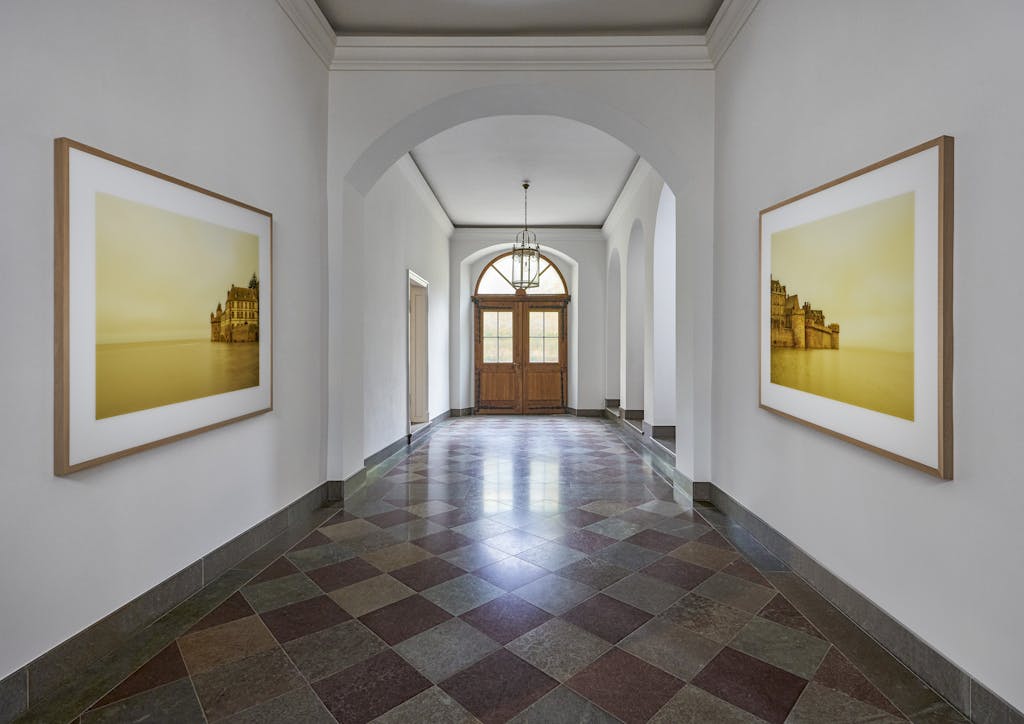Aestus, the Latin title of the exhibition, serves to designate the tides. Esser thus shows more than idealised landscapes: he depicts the silent natural forces of ebb and flow, which, determined by the effects of the moon, the coasts and the winds, expose and conceal the Normandy mudflats in a perpetual cycle. The height of the wide horizon in the picture places the focus on the water and its forces, the surf, the current, the whirlpools, or on the clouds. All this is pierced and accompanied by the light of dawn or day, sometimes glaring, sometimes diffuse.
These new works fit into Esser’s oeuvre, which, with seascapes, landscapes and vedute, moves within genres that are unusual for an artist of the Düsseldorf ‘Becher School’. Looking at his pictures, one might feel taken back to the 19th century, to the beginnings of photography. Esser’s preoccupation with the history of art and photography becomes apparent when looking at the composition. In particular, the seascapes with their depiction of impressive cloud formations are reminiscent of photographs by Gustave Le Gray (1820–1884). This applies not least to the regions that Esser has already travelled to and photographed in earlier series of works: Italy, the Middle East and, frequently, France.
"There are nice spots and holy places. I prefer the second ones. For thirty years now, I have been working on my view of France, between known and unknown places. Constructing utopias and imagination and still believing in poetry." – Elger Esser
So much of Esser’s work seems familiar to our visual memory, such as the framing or the repoussoirs, even if the pinnacles of the abbey in the foreground reveal a surprising, overwhelming view. Esser uses large-format cameras for the photographs and largely analogue processes in the further processes. For the pictures shown here, he exposed silver-plated copper plates, an experimental development in light-image design that gives both the depth in the picture and the glow of the light an almost painterly expression.
Not least the images of the gloomy, fairytale-like architecture of the abbey and the medieval bastions surrounding it seem to have fallen out of time, since the mountain church has remained unchanged for centuries. Esser’s pictures do not show the ephemeral. He chooses his motifs without any obvious reference to the present, thus leaving the viewer with a multitude of possible references from literature, painting or cultural history. With his pictures, Esser raises awareness of the moment and its uniqueness, whether it lasts a while or only briefly.
The past is not an assertion here. Rather, it becomes clear that Esser does not adopt the claim that photography should be used to depict the fluctuation of time and the world – the current state of things, in other words, in terms of form and technique or content and motif. Even without doing this, it is clear that his works are images of this time. For he does not stage them – the artist creates the sublimity of the pictures by visualising the beauty of the view, by no means nostalgically, at most melancholically.
Elger Esser leads the viewer to a subjective experience of time, and for this he does not stage. He works with what he sees, with the landscape and the temperament of nature. Esser’s pictorial ideas reveal themselves through the materiality of his works, through the surface, the shine and the depth, the colour and all its oscillations. His paintings open up views of powerful but quiet harmony and beauty – they open up the view of the seascapes of Normandy, but more so to our pictorial sensibility and to the moment and time.
The exhibition ELGER ESSER: AESTUS I, which was on show at KEWENIG's Pied-à-terre in Berlin-Charlottenburg until 11 November, was the prelude to this presentation.
